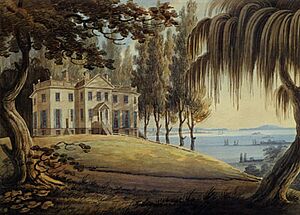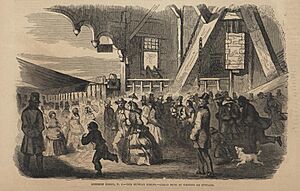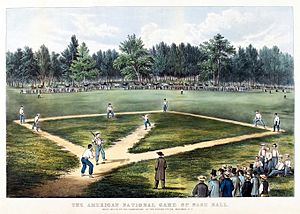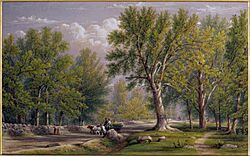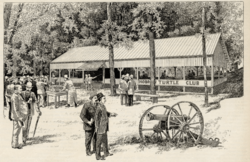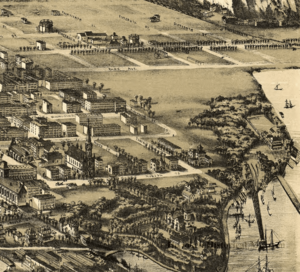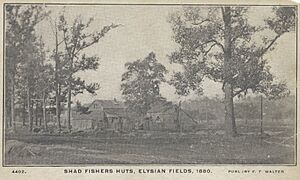Elysian Fields (Hoboken, New Jersey) facts for kids
The Elysian Fields in Hoboken, New Jersey, was a large park and fun place along the river in the 1800s. It was a popular spot for people from New York City to visit, like a big outdoor playground. Here, people could enjoy many sports, shows, and fun activities.
The park had a fancy hotel called the Colonnade, picnic areas, a special spa called Sybil's Cave, and paths for walking by the river. You could also go fishing, ride a miniature train, enjoy rides and races, and catch a ferry to and from the city. It was also a starting point for boat races.
The Elysian Fields was famous for hosting many baseball games. These were played by amateur teams from New Jersey, Manhattan, and Brooklyn before baseball became a professional sport (from the 1830s to the 1870s). Cricket matches were also very popular here, and the New York Yacht Club even had a place at the Fields.
The park stretched from what is now 8th Street north towards Weehawken, and from Washington Street east to the Hudson River. It was created in the 1820s and 1830s on land owned by Colonel John Stevens III and his family.
Historian Tom Gilbert said that the Elysian Fields was like a "laboratory" for fun and travel. He believed that places like Disneyland, Central Park, Coney Island, and modern baseball stadiums all have roots in the Elysian Fields.
Contents
Early History of the Area
This area was first called "Hobuck Island." In the 1700s, it was a large estate owned by the important Bayard family. During the American Revolutionary War, William Bayard supported the British. Because of this, after America won its independence, his land was taken by the government and sold. Colonel Stevens bought the estate in 1783. In 1788, he bought another 125 acres in a rural area called Weehawken. With these purchases, Stevens owned more than a mile of land along the Hudson River.
In the early 1800s, the Stevens property in Weehawken became known as "The Dueling Ground." This was where people from New York City went to settle arguments with pistols, because dueling was against the law in New York. It was on this land that Aaron Burr fatally shot Alexander Hamilton in 1804.
The Stevens family lived in a large house called a villa on top of Castle Point. This bluff overlooked the Hudson River and was surrounded by beautiful gardens. According to historian Melissa Abernathy, these gardens grew many vegetables, fruit trees, and hundreds of different kinds of flowering plants and exotic plants.
At that time, most of Hoboken was undeveloped and swampy, full of mosquitoes. There were also many turtles, which is why the swampy areas were known as "Turtle Grove." This led to the founding of The Hoboken Turtle Club in 1796. The club was famous for serving turtle soup and turtle steak dinners to its members.
In the 1820s, the Stevens family started to drain the swamp and fill in the nearby marshlands. The family was interested in engineering, invention, sports, and business. They began to imagine the waterfront area below their estate as a fun resort for New Yorkers. People could escape the city during hot summers and on weekends.
In 1824, before the park was fully developed, Colonel Stevens offered to sell the land to New York City to be used as a public park. This was many years before Central Park was created. However, New York City decided not to buy the land, so Colonel Stevens decided to finish the project himself.
Developing the Fun Park
Stevens described the new parkland as a "place for everyone, citizens and visitors, for health and fun." He proudly said that the park was "easy to reach." He added that "in a few minutes the dust, noise, and bad smells of the city may be exchanged for the pure air, delightful shades, and completely rural scenery."
The Elysian Fields became a very popular place for New Yorkers who wanted a break from city life. Ferries brought visitors from different streets in Manhattan, like Barclay, Canal, and Christopher Streets. Historian William Mann wrote that from about 1810 until the Civil War, New Yorkers loved to visit the Elysian Fields in the summer. Famous visitors included Charles Dickens, Edgar Allan Poe, and Washington Irving. Many writers described the park in their works. During its busiest time in the mid-1800s, the park attracted up to 20,000 visitors on weekends. This brought a lot of money to the Stevens family.
The original Stevens family house was destroyed in a fire in the early 1850s. A new castle was built in its place in 1854.
Baseball and Cricket Games
While Hoboken often says the Elysian Fields was the "birthplace" of baseball in 1846, this is a myth. Many baseball clubs and games were played in the 1830s, and even earlier, in Hoboken, New York City, Brooklyn, and other places. The first rules for baseball were actually written by the Gotham Club of New York in 1837. However, even if Hoboken isn't the "cradle of baseball," it was very important in the early days of the game. It helped baseball grow from a simple hobby into a competitive sport that people paid to watch.
The Knickerbocker Club of New York City, started in September 1845, is often mentioned as the first club to play baseball. Their first game is often said to have happened in Hoboken in 1846. But other clubs played baseball at the Elysian Fields before the Knickerbockers. Historian John Thorn notes that the Magnolia Ball Club and the New York Club (also known as the Gothams) played there in the autumn of 1843. Baseball historian Bill Ryczek explains that while the Knickerbockers kept very detailed records, many other clubs played before them but didn't record their games as carefully.
By 1845, new buildings were taking over open spaces in New York City. This led the Knickerbockers to choose the Elysian Fields as their home field. It was only a 15-minute ferry ride from lower Manhattan.
On June 19, 1846, the Knickerbockers played against the New York Ball Club. This game is often seen as the first fully documented baseball game. Many games happened before this one; 37 earlier matches at the Elysian Fields alone before June 19, 1846, have been recorded. The Knickerbockers were simply the first to write down a detailed account of the game, like the first "scorecard." In this game, New York beat the Knickerbockers 23-1 in four innings. The Knickerbockers mostly played games among their own members, not against other clubs.
By the late 1850s, several top baseball clubs from Manhattan, like the Gothams, Eagles, and Empires, along with the Knickerbockers, used the Elysian Fields as their home field. The Mutual Club of New York started playing there in 1857. In 1865, they improved a baseball diamond and added stands for fans to watch.
The New York Cricket Club was formed at McCarty's Hotel (the Colonnade) on October 11, 1843. The St. George's Cricket Club, which started in Manhattan in 1839, made the Elysian Fields their home in the 1850s. In 1859, a big international cricket match was held there. An All-England Eleven team visited as part of an English tour of North America.
Sports writer Henry Chadwick, who reported on cricket for The New York Times, often watched baseball games at the Elysian Fields in the 1850s. Many athletes at that time were good at both sports. After watching a game between the Gotham and Eagle clubs, Chadwick became a huge fan of baseball. He wrote about the sport for the next 50 years and was later inducted into Baseball's Hall of Fame.
Chadwick wasn't the only one who saw the potential of baseball. During this time, newspapers started to report on local games. Clubs made up of newspaper writers even played at the Elysian Fields in the 1850s and 1860s. In 1871, a baseball field was set aside just for them.
In 1865, the Elysian Fields hosted a championship baseball game between the Mutuals and the Atlantic Club of Brooklyn. About 20,000 fans attended this event. A famous Currier & Ives lithograph called The American National Game of Base Ball shows this game, though historians say it's more of a fantasy picture than a real depiction.
By 1870, some people tried to cause trouble at amateur matches. In 1871, the New York Clipper reported that "crowds of roughs" annoyed players. So, Hoboken authorities stepped in and only allowed clubs with special permission to play.
Baseball was played at the Elysian Fields for about 50 years. The last known newspaper mention of a game there was in 1889. By the early 1890s, the Elysian Fields had been divided up by new buildings, and only small parts of the park remained.
The only professional games known to have been played on the Elysian grounds were in 1888. These were championship matches between black (Negro league) teams.
The Colonnade Hotel
In 1830, the Stevens family built a Greek-style building near Turtle Cove called the Colonnade. It opened in 1831. Stevens said it was a place for fun and celebration. There was already a tavern nearby called the "'76 House," or "Tavern on the Knoll," located between the ferry dock and the Stevens mansion. The Colonnade had a "white front and Doric pillars," making it look very grand. It appeared in many pictures of the Elysian Fields from the 1800s. It was a favorite spot for baseball players after their games.
An Irish man named Michael McCarty became the owner in 1841. The place became so well-known as his that people often called it McCarty's Hotel. It was also sometimes called the "Pavilion." For special events, McCarty would set up stages or tents around the hotel so guests could eat and drink while enjoying the scenery. McCarty even joined the Knickerbocker Club and played in some of their baseball games.
The Colonnade continued to operate for many years under different owners, who often renamed it. In the 1880s, it was known as Charles W. Roedenburg's lager beer saloon.
The building was likely torn down in 1893. A newspaper article from November 1893 said, "The old hotel was demolished but a short time ago."
Sybil's Cave
The spa called Sybil's Cave was dug out around 1832 by Hoboken's founder, Colonel John Stevens III. It was decorated with a stone arch in a gothic style. The cave was named after the ancient Greek and Roman prophetesses. From the 1840s to the 1880s, it was a major tourist attraction in Hoboken. People believed the water flowing from a spring inside the cave, which contained magnesium, was good for their health. In the mid-to-late 1800s, a glass of this water cost one penny.
Historian Tom Gilbert wrote that the Stevenses created Sybil's Cave from an old iron mine. It was a fake grotto that served as a fun attraction and a place to get refreshments. Visitors walking along the river path would stop there to buy water, which they believed came from a spring in the cave and had healing powers.
The cave became nationally known in 1841 when the body of a young cigar shop worker, Mary Cecilia Rogers, was found nearby. This event inspired Edgar Allan Poe's The Mystery of Marie Rogêt, which was one of the first true crime detective novels.
Other Fun Things to Do
In the 1830s, a group of Penobscot Native Americans came from Maine to perform and sell handmade items. For over ten years, they put on "Indian dances," held canoe races, and sold beautiful handmade baskets to tourists. Jugglers, rope dancers, musicians, and magicians performed for the crowds. There were also carnival rides and lots of delicious food.
At the north end of the park, there was a deer park and a horse "Trotting Course" for racing. Stevens loved speed and owned racehorses. He also pushed for the New Jersey government to make horse-racing legal. His interest in fast horses was connected to his goal of having the fastest stage coaches in New Jersey. He even wanted to have a monopoly on carrying the U.S. mail. The Stevens family had a stable and a horse breeding service with other important families. Colonel Stevens' wife, Rachel, wrote that the men would visit the park daily to talk and watch their racehorses, feeling very happy.
A fight broke out in Hoboken in 1835 during a boxing match.
Because of such incidents and the bad publicity, fewer people started coming to the park in the mid-1830s. Historian William Mann wrote that during the last years of Colonel Stevens' life (he died in 1838), his park began to slowly decline. To attract more visitors, Stevens organized events like music concerts, ox roasts, Native American war dances, sideshow acts, boxing matches, sailboat races, hot-air balloon shows, and speaking competitions. Even with these efforts, the park was becoming less popular and gaining a reputation for being a bit rough.
The tree-lined paths of the Elysian Fields also became known as "lovers' paths," where couples could spend time together.
The Park's Decline
By the early 1870s, Hoboken's waterfront became more industrial and the area around it started to look run-down. The charm of the Elysian Fields, the Colonnade, and Sybil's Cave as tourist spots began to fade. By this time, all the Stevens family members who founded the park had passed away. The original goal of the Stevens family was to use the park to attract people to buy land in Hoboken, and they had succeeded. So, the Elysian Fields no longer served that purpose.
In the early 1860s, two major baseball parks with fences were built in Brooklyn. These parks allowed organizers to charge money for admission to games. This made the Elysian Fields less important as a place for baseball and cricket. The St. George Cricket Club moved from the Elysian Fields in 1865 to find playing space in New York. In 1868, the top Manhattan baseball club, the New York Mutuals, moved their home games from the Elysian Fields to the Union Grounds in Brooklyn.
When Central Park was finished in New York City in the 1860s, New Yorkers had a new place in Manhattan to relax and have fun. This meant they didn't have to cross the Hudson River to Hoboken. (Interestingly, New York City did not allow baseball in Central Park.) Until the Polo Grounds in Upper Manhattan were rented to the New York Metropolitans in 1880, most New York-area teams after the Civil War were based in Brooklyn. The New York Clipper newspaper wrote in 1869: "This is probably the last season of the once famous Elysian Fields as a place of resort for our metropolitan ball clubs." The old New York clubs that started playing there in the 1840s and 1850s—the Gothams, Knickerbockers, Empire, and Eagles—continued to play in Hoboken until the 1870s. However, by then, baseball had become a professional sport, and these old amateur clubs were no longer competitive.
In 1879, the New Jersey Athletic Club opened new sports grounds on what was left of the northeastern part of the Elysian Fields. These grounds hosted bicycle and foot races, pole-leaping, hammer throwing, shot-put, and other athletic competitions.
Sybil's Cave was closed in 1880 because of concerns from the health department about the water quality. It was then used as a cool storage area for a nearby restaurant. That restaurant eventually became a run-down tavern and closed in the 1930s. The cave was then filled with concrete and dirt.
Tom Gilbert wrote that by the mid-1890s, "The baseball fields gave way to piers, warehouses, and more railroad tracks."
A November 1893 article in the New York Herald newspaper had a dramatic headline: "Last of Famous Elysian Fields." It said that the "Long Favored Amusement Haunts of New Yorkers Soon to Disappear" and that "Historical Retreats and Honored Landmarks of Early Days Now Being Rapidly Obliterated."
The Area Today
The Elysian Fields is now covered by modern streets and buildings. A Maxwell House Coffee plant was built on part of the former Elysian grounds in 1939. For many years, it was the biggest employer in town. Its tall "Good to the Last Drop" sign, with a giant tilted coffee cup, was a famous sight along Hoboken's skyline by the Hudson River. A local tavern called Maxwell's, where the plant's workers often went, was located nearby. In the 1970s, Maxwell's became a well-known bar, restaurant, and indie-rock music club. The Maxwell House plant closed in 1990 and was later torn down. High-rise condominium buildings were built in its place.
The only remaining part of the Elysian Fields for recreation is a small playground called Elysian Park. It is bordered by Hudson Street to the west, Frank Sinatra Drive to the north and east, and stretches from 10th to 11th Streets. A scene from the 1954 film On the Waterfront, starring Marlon Brando and Eva Marie Saint, was filmed in Elysian Park along its iron fence overlooking the Hudson. There is no baseball field in the park today.
The Stevens family name lives on at the Stevens Institute of Technology. This university is located south of where the Elysian Fields used to be. It was founded in 1868 through a gift from Edwin Augustus Stevens. As of 2021, over 8,000 students were enrolled there.
At the corner of 11th and Washington Streets, a few blocks west of Elysian Park, a marker was placed where one of the two Elysian Fields baseball diamonds is thought to have been. However, the exact spot is not certain because the neighborhood and streets have changed a lot since the mid-1800s, and the waterfront has been extended with new land. In 2003, a local group called the Hoboken Industry and Business Association placed concrete and bronze "base" monuments on the sidewalk at the intersection's corners. A bronze plaque explaining the connection to early baseball was placed in the middle strip of 11th Street, between where first and second bases would have been.


